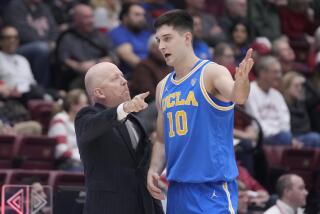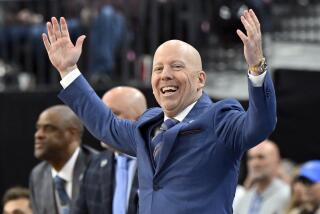Dynasty in the Making : Women’s basketball: Stanford has won two national titles and could be on the way to another.
PALO ALTO — Midway through the second half of a Pacific 10 conference game with California, Stanford freshman Kristin Folkl grabs a rebound and throws a length-of-the-court, perfectly timed pass to sophomore Kate Starbird, who scores an easy layup.
The crowd of 7,077 at Maples Pavilion roars its approval.
Only 20 seconds later, Folkl grabs another rebound, throws another length-of-the-court, perfectly timed pass to Starbird and again Starbird scores an easy layup.
The crowd of 7,077 at Maples Pavilion goes wild.
The four points in 28 seconds make the score 66-42. The Cardinal were pulling away from Cal, a team they would go on to blow out, 99-65. But Folkl’s and Starbird’s double play wasn’t the only crowd-pleaser of the night. There was Starbird’s behind-the-back dribble late in the second half as she drove in the lane and ended up with two points. There was a long pass from senior Rachel Hemmer to junior Bobbie Kelsey, who made a tip pass to Starbird in one fluid motion. There was the physical, aggressive rebounding of Olympia Scott, who whose 12 rebounds led the team.
This was the Big Time -- a perennial top 10 team, a squad full of high school All-Americans, a sellout crowd, pep bands and mascots and ESPN cameras.
Everything but Dick Vitale.
But who needs Dickie V when you have Nancy Lieberman Cline? In Starbird, Coach Tara VanDerveer has an emerging star who leads the team in points and assists. Hemmer and senior Anita Kaplan were all-conference last season. Senior Kate Paye has an eye for defense and Kelsey a shooting touch. They’re so deep, it’s scary.
Stanford has won two national titles and could be on the way to another. The reason: VanDerveer and her staff recruited one of the most heralded freshman classes in college basketball since five guys named Rose, Howard, Webber, Jackson and King went to Michigan in 1991.
Stanford’s recruits are not only good, they’re big. Besides Folkl, a 6-foot-2 forward; and Scott, a 6-2 forward; there is 6-2 Heather Owen; 6-0 Regan Freuen; 6-3 Naomi Mulitauapele (pronounced MOO-lee-ta-wa-oh-peh-leh); and 6-7 Chandra Benton, who was redshirted. Redshirt freshman Vanessa Nygaard, an aggressive 6-0 forward, also contributes, and all are seeing significant playing time. Scott has started every game this season, and as a group the freshmen average 11.6 minutes a game playing time.
“The recruiting class she brought in was just amazing,” Tennessee Coach Pat Summitt says. “Tara and her staff have done a great job going out and getting some of the top players in the country.” The Six Pack -- as they call themselves -- are one reason Stanford will remain among college basketball’s elite until, oh, about the next century. As of last Sunday, the Cardinal were 17-2 -- with an average margin of victory of 34.5 points -- although they saw a 15-game winning streak broken Saturday in a loss at Oregon State. That didn’t concern VanDerveer too much, however. She thinks it will help her team in the long run.
“We haven’t been at the right pace,” VanDerveer says. “Winning games by 30, 40, 50 points is not realistic. Those won’t help us as much as this loss will.”
The other loss was a 105-69 pounding December 1 by then-No.1 Tennessee in Knoxville -- early enough in the season to be looked upon as a learning experience rather than a cause for concern.
Stanford is still a good bet for a top seed in the West in the NCAA Tournament, and the coaching staff says this can be the season the Cardinal take home their third title. “We have the talent, the depth, the chemistry and the work habits,” assistant Julie Plank says. “I look at the reasons we won it all before, and this team has it.”
VanDerveer places a lot of value on the team’s depth and chemistry. “Other top 10 teams have comparable size that we have,” VanDerveer says. “We’re dealing with situations that on other teams, you’d have a lot of grousing. But people are putting the team’s success first. That kind of unselfishness will take our team a long way.”
That’s the kind of team Cardinal fans, who pack Maples Pavilion game after game, have come to expect. Maybe it’s the style of play that keeps bringing the fans back -- behind-the-back passes and between-the-leg dribbles; the run-and-gun, the fast break, the full-court passes, the contact inside the lane. Get the pass and turn and shoot -- quick! -- because she’s in my face.
*
Before the road trip to Oregon, the Cardinal were fourth in the nation in scoring (87.9 points per game), third in scoring margin (28.0) and third in field goal percentage (50.1 percent.) Why Stanford? How did this San Francisco Bay-area campus become a Mecca for the masterful, a training ground for the young and talented? Never mind its beautiful campus with some of the finest facilities in country. Ask the freshmen why they decided on Stanford and to a woman they cite academics.
“Women don’t have the same opportunities (as men do) to play after college,” Benton says. “I wanted to make sure I had a good education to fall back on.”
There are no stars in these players’ eyes. They know most women do not get agents or shoe contracts and they must invest in other areas of their lives, which means education. For female athletes, college is not a means to an end; college is the end. That’s why Stanford attracts so many blue-chip players. It’s the total package -- education and athletics.
For Folkl, winner of the Dial Award as the top female high school athlete in the country last year, Stanford was an easy choice. Not only does she have superior skills in basketball and volleyball (a first team All-American as a freshman), she carried a weighted 4.2 grade-point average on a 4.0 scale in high school. Yet Folkl is unassuming and unpretentious and seemingly unaware that she is quite possibly the best and most versatile female college athlete in the country.
“There are so many talented people here, it’s kind of humbling,” Folkl says. “There’s a girl who lives down the hall in my dorm who’s a concert pianist. She’s always practicing, playing beautiful music. Everyone has their gift here. Although you’re accomplished, others are too. People aren’t in awe of each other.”
It was that sense of accomplishment, this gathering of the best and the brightest, that led the others to Stanford as well.
“Why wouldn’t you want to come here?” Lieberman Cline asks. It wasn’t always this way for Stanford. When VanDerveer arrived from Ohio State in 1985, bringing assistants Plank and Amy Tucker with her, Stanford was coming off a 9-19 season and had never been among the women’s elite programs.
VanDerveer’s hiring was a coup for then-Athletic Director Andy Geiger. She had just taken Ohio State to the quarterfinals of the NCAA Tournament and she was coming to a program that had gone 14-42 the previous two seasons. But VanDerveer made the move, she says, because it seemed like the right fit.
“I had never really known about Stanford,” says VanDerveer, a Boston native who grew up in upstate New York. “For me, this would be a dream, too, if I were a high school player. I think that’s why I coach here. Although I tease my assistants, they would have recruited me then and said, ‘No, you’re too slow.’ But I think I could have gotten in. I had the grades and the test scores.”
VanDerveer and her staff went from a 13-15 record in 1985-86 to a 27-5 record in 1987-88. By their fifth season they had their first national title.
Recruiting was the challenge in the early days, and it’s an area in which the coaching staff has excelled. VanDerveer credits her assistants, especially Tucker.
“Amy can really identify young players who are going to be great,” VanDerveer says. “She would save teams a lot of money in the NBA. She can really look and project which players are going to go on and make it as far as their potential and ability. She just has a great eye for that.”
Tucker laughs when she’s told VanDerveer thinks she has a future in some NBA team’s scouting department. “I just go with my gut feeling,” Tucker says. “I know what I like. I try to look for the type of skills that fit into our program.”
VanDerveer is content to leave the recruiting to Tucker, Plank and third assistant Carolyn Jenkins. “I really try to focus more on our team than I do on the recruits,” VanDerveer says. “I just feel my responsibility is to the players who are at Stanford.”
When she does talk to a recruit, she says she’s all business. “If anything in recruiting -- and I’m criticized by my assistants for this -- is I’m blunt,” VanDerveer says. “I’m so honest, it’s scary.
“They’re like, ‘You don’t have to tell them that.’ A player will say, ‘I’m worried about my playing time. I’m a guard, and I’m worried I won’t play much.’ I’ll tell them, well, you don’t have to worry about the people who are on our team now, but there’s this (high school) junior that’s really ...
“I’ll sit down and really talk to them about ‘This is what I really think.’ Sometimes that’s not good in the short run, but it works in the long run.”
That’s for sure. So well that the staff has changed its recruiting pitch. “Before it was, ‘We’re not very good, but we’re going to be good. You’ll play right away,’ ” Tucker says. “Now it’s different. If anything, we lose kids because we’re too good.”
That’s the problem Stanford faces next season. After two bountiful November harvests, Stanford did not sign any recruits in last November’s early-signing period.
“We went after three players hard,” Tucker says. “We lost them because they could not see themselves stepping in and playing right away.” Joe Smith, who has been following women’s basketball for more than 20 years as director of the Women’s Basketball News Service, says Stanford struck out for the first time in the VanDerveer Era. “Whenever you have a great recruiting class like they did, you’ll have trouble the next season,” Smith says. “Recruits can look at the roster and see how little playing time they’ll have. It was a matter of timing. This year, kids just wanted to go elsewhere.”
But Tucker isn’t too worried about this year’s recruiting drought. She’s already working on high school juniors. “We lost three kids -- there are no backups,” Tucker says. “You don’t have second choices. We’ll just focus on the next class. I’ve just sent out letters to all the juniors saying, ‘Watch us on ESPN, if you can stay up that late.’ ”
*
Nine hours before the Cal game, the team is assembled in an empty Maples Pavilion for the gameday shootaround. VanDerveer is going over the game plan, running them through play after play, cajoling and yelling and urging and pushing the team to get it right.
Frustrated with a sudden rash of mistakes, VanDerveer, who had been quietly standing by on the court, becomes agitated. “We need someone who’s going to finish, not turn it over,” VanDerveer yells. “Get it right now or tonight you will not be in there making those kinds of plays.”
The team takes notice, going over again and again the plays they will see Cal run. Even the best collection of talent needs to be jump-started from time to time.
Later, it’s obvious the drills pay off. A few minutes into the game, the offense is running like a machine.
Just like the Stanford women’s basketball program.
More to Read
Go beyond the scoreboard
Get the latest on L.A.'s teams in the daily Sports Report newsletter.
You may occasionally receive promotional content from the Los Angeles Times.










